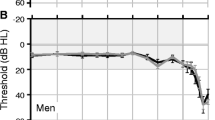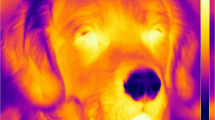Abstract
In this study, we examined the relationship between a measure of cerebral lateralization—differences in tympanic temperature (T Ty)—and questionnaire measures of inattentiveness and hyperactivity in both people and dogs. Theories of cerebral lateralization indicate that cerebral asymmetry may improve attentive behaviour. In people, greater left than right T Ty was related to increased self-reports of inattentiveness. There was no relationship between lateralized T Ty and hyperactivity. In dogs, there was quadratic relationship between lateralized T Ty and handler reports of inattentiveness. Increased T Ty asymmetry, regardless of direction, was related to more attentiveness. There was no discernable relationship between hyperactivity and lateralized T Ty. Differences in T Ty may be an useful tool for investigating species comparisons of cerebral lateralization.

Similar content being viewed by others
References
Boles DB, Barth JM, Merrill EC (2008) Asymmetry and performance: toward a neurodevelopmental theory. Brain Cognit 66:124–139
Boyce WT, Essex MJ, Alkon A, Smider NA, Pickrell R, Kagan J (2002) Temperament, tympanum, and temperature: four provisional studies of the biobehavioral correlates of tympanic membrane temperature asymmetries. Child Dev 73:718–733
Cherbuin N, Brinkman C (2004) Cognition is cool: can hemispheric activation be assessed by tympanic membrane thermometry? Brain Cogn 54:228–231
Cherbuin N, Brinkman C (2007) Sensitivity of functional tympanic membrane thermometry (fTMT) as an index of hemispheric activation in cognition. Laterality 12:239–261
Corballis MC (2006) Cerebral asymmetry: a question of balance. Cortex 42:117–118
Corballis MC (2009) The evolution and genetics of cerebral asymmetry. Philos Trans R Soc B 364:867–879
Guo K, Meints K, Hall C, Hall S, Mills D (2009) Left gaze bias in humans, rhesus monkeys and domestic dogs. Anim Cogn 12:409–418
Hale TS, Loo SK, Zaidel E, Hanada G, Macion J, Smalley SL (2009) Rethinking a right hemisphere deficit in ADHD. J Attention Disorders 13:3–17
Helton WS (2010) The relationship between lateral differences in tympanic membrane temperature and behavioral impulsivity. Brain Cogn 74:75–78
Helton WS, Carter J (2011) The effect of investigator gender on lateral tympanic membrane temperature. Laterality 16:156–163
Helton WS, Hollander TD, Tripp LD, Parsons K, Warm JS, Matthews G, Dember WN (2007) Cerebral hemodynamics and vigilance performance. J Clin Exp Neuropsychol 29:545–552
Helton WS, Hayrynen L, Schaeffer D (2009) Sustained attention to local and global target features is different: performance and tympanic membrane temperature. Brain Cogn 71:9–13
Heusch AI, Suresh V, McCarthy PW (2006) The effect of factors such as handedness, sex and age on body temperature measured by an infrared ‘tympanic’ thermometer. J Med Eng Tech 30:235–241
Hirnstein M, Leask S, Rose J, Hausmann M (2010) Disentangling the relationship between hemispheric asymmetry and cognitive performance. Brain Cogn 73:119–127
Hopkins WD, Fowler LA (1998) Lateralized changes in tympanic membrane temperature in relation to different cognitive tasks in chimpanzees (Pan troglodytes). Behav Neurosci 112:83–88
Jackson CJ (2011) Evidence of a relationship between asymmetries in tympanic membrane temperature and lateralized sensory preferences. Laterality 16:107–124
Kessler RC, Adler L, Ames M, Demler O, Faraone S, Hiripi E et al (2004) The World Health Organization adult ADHD self-report scale (ASRS): a short screening scale for use in the general population. Psychol Med 35:245–256
Lawrence NS, Ross TJ, Hoffman R, Garavan H, Stein EA (2003) Multiple neuronal networks mediate sustained attention. J Cogn Neurosci 15:1028–1038
Lim J, Wu W, Wang J, Detre JA, Dinges DF, Rao H (2010) Imaging brain fatigue from sustained mental workload: an ASL perfusion study of the time-on-task effect. NeuroImage 49:3426–3435
Lit L, Schweitzer JB, Iosif AM, Oberbauer AM (2010) Owner reports of attention, activity, and impulsivity in dogs: a replication study. Behav Brain Funct 6:1
Lubke GH, Muthen B, Moilanen IK, McGough JJ, Loo SK, Swanson JM et al (2007) Subtypes versus severity differences in attention deficit/hyperactivity disorder in the Northern Finnish birth cohort. J Am Acad Child Adol Psychiat 46:1584–1593
Mariak Z, White MD, Lyson T, Lewko J (2003) Tympanic temperature reflects intracranial temperature changes in humans. Eur J Physiol 446:279–284
Mazzotti GA, Boere V (2009) The right ear but no the left ear temperature is related to stress-induced cortisolaemia in the domestic cat (Felis catus). Laterality 14:196–204
Oldfield R (1971) The assessment and analysis of handedness: the Edinburgh inventory. Neuropsychology 9:97–113
Pardo JV, Fox PT, Raichle ME (1991) Localization of a human system for sustained attention by positron emission tomography. Nature 349:61–63
Quaranta A, Siniscalchi M, Frate A, Vallortigara G (2004) Paw preference in dogs: relations between lateralised behaviour and immunity. Behav Brain Res 153:521–525
Quaranta A, Siniscalchi M, Vallortigara G (2007) Asymmetric tail-wagging responses by dogs to different emotive stimuli. Curr Biol 17:199–201
Quaranta A, Siniscalchi M, Alrizio M, Volpe S, Buonavolgia C, Vallortigara G (2008) Influence of behavioural lateralization on interleukin-2 and interleukin-6 gene expression in dogs before and after immunization with rabies vaccine. Behav Brain Res 186:256–260
Rogers LJ (2000) Evolution of hemispheric specialization: advantages and disadvantages. Brain Lang 73:236–253
Rogers LJ (2009) Hand and paw preferences in relation to the lateralized brain. Philos Trans R Soc B 364:943–954
Rogers LJ, Andrews RJ (2002) Comparative vertebrate lateralization. Cambridge University Press, Cambridge
Rogers LJ, Zucca P, Vallortigara G (2004) Advantages of having a lateralized brain. Proc R Soc Lond B 271:420–422
Schuman MU, Suhr DF, Grosseln HH, Brauer A, Jantzen JP, Samii M (1999) Local brain surface temperature compared to temperatures measured at standard extracranial monitoring sites during posterior fossa surgery. J Neurosurg Anesthes 12:90–95
Siniscalchi M, Quaranta A, Rogers LJ (2008) Hemispheric specialization in dogs for processing different acoustic stimuli. PLoS ONE 3:e3349
Siniscalchi M, Sasso R, Pepe AM, Dimatteo S, Vallortigara G, Quaranta A (2010a) Catecholamine plasma levels following immune-stimulation with rabies vaccine in dogs selected for their paw preferences. Neurosci Let 476:142–145
Siniscalchi M, Sasso R, Pepe AM, Vallortigara G, Quaranta (2010b) Dogs turn left to emotional stimuli. Behav Brain Res 208:516–521
Siniscalchi M, Franchini D, Pepe AM, Sasso R, Dimatteo S, Vallortigara G, Quaranta A (2011a) Volumetric assessment of cerebral asymmetries in dogs. Laterality 16:528–536
Siniscalchi M, Sasso R, Pepe AM, Dimatteo S, Vallortigara G, Quaranta A (2011b) Sniffing with the right nostril: lateralization of response to odour stimuli by dogs. Anim Behav 82:399–404
Stefanatos GA, Wasserstein J (2001) Attention deficit/hyperactivity disorder as a right hemisphere syndrome: selective literature review and detailed neuropsychological case studies. Ann NY Acad Sci 931:172–195
Sukstanskii AL, Yablonskiy DA (2006) Theoretical model of temperature regulation in the brain during changes in functional activity. Proc Natl Acad Sci USA 103:12144–12149
Tomkins LM, McGreevy PD, Branson NJ (2010) Lack of standardization in reporting motor laterality in the domestic dog (Canis familiaris). J Vet Behav 5:235–239
Vallortigara G (2000) Comparative neuropsychology of the dual brain: a stroll through animals’ left and right perceptual worlds. Brain Lang 73:189–219
Vallortigara G, Rogers LJ (2005) Survival with an asymmetrical brain: advantages and disadvantages of cerebral lateralization. Behav Brain Sci 28:575–589
Vas J, Topal J, Pech E, Miklosi A (2007) Measuring attention deficit and activity in dogs: a new application and validation of a human ADHD questionnaire. Appl Anim Behav Sci 103:105–117
Wells DL (2003) Lateralised behaviour in the domestic dog, Canis familiaris. Behav Process 61:27–35
Acknowledgments
We would like to thank Carlo Alberto Marzi, Lesley J. Rogers, and an anonymous reviewer for providing constructive feedback on this paper. The research was supported by a University of Canterbury science grant.
Author information
Authors and Affiliations
Corresponding author
Rights and permissions
About this article
Cite this article
Helton, W.S., Maginnity, M. Increased attentiveness is associated with hemispheric asymmetry measured with lateral tympanic membrane temperature in humans and dogs. Exp Brain Res 219, 321–326 (2012). https://doi.org/10.1007/s00221-012-3093-9
Received:
Accepted:
Published:
Issue Date:
DOI: https://doi.org/10.1007/s00221-012-3093-9




